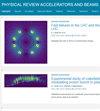横条H型直列加速器腔的场平坦化概念
IF 1.8
3区 物理与天体物理
Q3 PHYSICS, NUCLEAR
Physical Review Accelerators and Beams
Pub Date : 2024-04-05
DOI:10.1103/physrevaccelbeams.27.040101
引用次数: 0
摘要
目前正在开发横杆 H 型空腔(CH-DTL,H21 模式),以改进这种极具吸引力的漂移管直列加速器(DTL)的技术。与传统的 DTL 相比,H 型空腔可以达到更高的有效场梯度,并且在高达 100 A MeV 的能量范围内具有分流阻抗方面的竞争力。在应用 KONUS 射束动力学时,H 型 DTL 在分流阻抗方面更具优势。研究实验室和医院都在使用这些设备。本文介绍了一种在 CH 型腔中接近零模式的新概念,即通过结合倾斜漂移管杆来延长腔体两端的直径。四叶片型 RFQ 也可在 H210 模式下运行,如果传统叶片下切造成问题,也可部分采用电压平坦化策略。由于一个 KONUS 部分相对较短,而且无法充分利用 300 MHz 以上的 3 MW klystrons 的全部射频功率,因此将一个或多个三重透镜集成到每个空腔中的做法很有吸引力。这种腔体被称为耦合 CH 腔体 CCH。我们讨论了这些内部三重透镜的三种可能排列方式,并对它们进行了比较。然后,将工作模式以及更高的模式与无透镜 CH 腔(透镜位置由普通漂移管填充)进行比较。结果表明,所有四个研究阵列的射频行为和高次谐波频段的共振频率非常相似。这意味着,将偶数个普通漂移管(nβλ)换成足够长且外径较大的含透镜漂移管,就能简单地从无透镜 CH 腔推导出 CCH 腔的调谐行为。这个大漂移管本身的振荡类似于阿尔瓦雷斯型漂移管。对 30 个间隙的 CH 腔进行的射频模拟显示,当安装长度为 2 beta lambda 的透镜时,分流阻抗降低了约 10%。本文章由计算机程序翻译,如有差异,请以英文原文为准。

Field flattening concepts for linac cavities of the cross-barHtype
The development of cross-bar H-type cavities (CH-DTL, mode) is ongoing to improve the technology of this attractive type of drift tube linac (DTL). In comparison with the conventional DTL, the H-type cavities can reach a higher effective field gradient and are competitive in shunt impedance at an energy range up to 100 A MeV. H-mode DTL’s profit in shunt impedance additionally when applying the KONUS beam dynamics. They are in use at research laboratories as well as at hospitals. This paper describes a new concept to approach the zero mode in CH-type cavities, by extending the cavity diameter at the tank ends in combination with tilted drift tube stems. RFQs of the four-vane type are operated as well in the mode and the strategy for voltage flattening can be partly applied there too if conventional vane undercuts are causing problems. Up to around 35 MeV, it is attractive to integrate one or more triplet lenses into each cavity, as one KONUS section is relatively short and would not exploit the full rf power of 3 MW klystrons which are available above 300 MHz. Such a cavity is denoted as a coupled CH-cavity CCH. Three possible arrangements of those internal triplet lenses are discussed and are compared to each other. The operating modes as well as higher modes are then compared with a lens-free CH cavity, where the lens position was filled by ordinary drift tubes. As a result, it is shown that the rf behavior and resonance frequency for the higher harmonics of the frequency band are very similar for all four investigated arrays. This means, that the tuning behavior of the CCH cavity can be simply deduced from the lens-free CH cavity by replacing an even number of ordinary drift tubes () with a lens-containing drift tube with adequate length and large outer diameter. This large drift tube itself oscillates like an Alvarez-type drift tube. rf simulations on a 30-gap CH cavity show that the reduction in shunt impedance is about 10% when installing a lens with length 2 beta lambda.
求助全文
通过发布文献求助,成功后即可免费获取论文全文。
去求助
来源期刊

Physical Review Accelerators and Beams
Physics and Astronomy-Surfaces and Interfaces
CiteScore
3.90
自引率
23.50%
发文量
158
审稿时长
23 weeks
期刊介绍:
Physical Review Special Topics - Accelerators and Beams (PRST-AB) is a peer-reviewed, purely electronic journal, distributed without charge to readers and funded by sponsors from national and international laboratories and other partners. The articles are published by the American Physical Society under the terms of the Creative Commons Attribution 3.0 License.
It covers the full range of accelerator science and technology; subsystem and component technologies; beam dynamics; accelerator applications; and design, operation, and improvement of accelerators used in science and industry. This includes accelerators for high-energy and nuclear physics, synchrotron-radiation production, spallation neutron sources, medical therapy, and intense-beam applications.
 求助内容:
求助内容: 应助结果提醒方式:
应助结果提醒方式:


